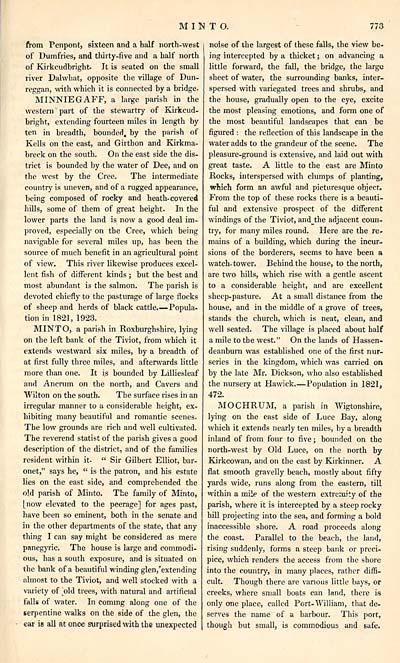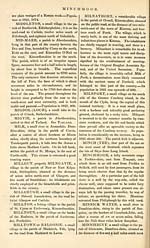Gazetteer of Scotland > Volume 2
(289) Page 773
Download files
Complete book:
Individual page:
Thumbnail gallery: Grid view | List view

M I N T O.
773
from Penpont, sixteen and a half north-west
of Dumfries, and thirty-five and a half north
of Kirkcudbright. Jt is seated on the small
river Dalwhat, opposite the village of Dun-
reggan, with which it is connected by a bridge.
MINNIE GAFF, a large parish in the
western part of the stewartry of Kirkcud-
bright, extending fourteen miles in length by
ten in breadth, bounded, by the parish of
Kells on the east, and Girthon and Kirkma-
breck on the south. On the east side the dis-
trict is bounded by the water of Dee, and on
the west by the Cree. The intermediate
country is uneven, and of a rugged appearance,
being composed of rocky and heath-covered
hills, some of them of great height. In the
lower parts the land is now a good deal im-
proved, especially on the Cree, which being
navigable for several miles up, has been the
source of much benefit in an agricultural point
of view. This river likewise produces excel-
lent fish of different kinds ; but the best and
most abundant is the salmon. The parish is
devoted chiefly to the pasturage of large flocks
of sheep and herds of black cattle. — Popula-
tion in 1821, 1923.
MINTO, a parish in Roxburghshire, lying
on the left bank of the Tiviot, from which it
extends westward six miles, by a breadth of
at first fully three miles, and afterwards little
more than one. It is bounded by Lilliesleaf
and Ancrum on the north, and Cavers and
Wilton on the south. The surface rises in an
irregular manner to a considerable height, ex-
hibiting many beautiful and romantic scenes.
The low grounds are rich and well cultivated.
The reverend statist of the parish gives a good
description of the district, and of the families
resident within it- " Sir Gilbert Elliot, bar-
onet," says he, " is the patron, and his estate
lies on the east side, and comprehended the
old parish of Minto. The family of Minto,
[now elevated to the peerage] for ages past,
have been so eminent, both in the senate and
in the other departments of the state, that any
thing I can say might be considered as mere
panegyric. The house is large and commodi-
ous, has a south exposure, and is situated on
the bank of a beautiful winding glen,'extending
almost to the Tiviot, and well stocked with a
variety of [old trees, with natural and artificial
falls of water. In Coming along one of the
serpentine walks on the side of the glen, the
ear is all at once surprised with the unexpected
noise of the largest of these falls, the view be-
ing intercepted by a thicket ; on advancing a
little forward, the fall, the bridge, the large
sheet of water, the surrounding banks, inter-
spersed with variegated trees and shrubs, and
the house, gradually open to the eye, excite
the most pleasing emotions, and form one of
the most beautiful landscapes that can be
figured : the reflection of this landscape in the
water adds to the grandeur of the scene. The
pleasure-ground is extensive, and laid out with
great taste. A little to the east are Minto
Rocks, interspersed with clumps of planting,
which form an awful and picturesque object.
From the top of these rocks there is a beauti-
ful and extensive prospect of the different
windings of the Tiviot, andthe adjacent coun-
try, for many miles round. Here are the re-
mains of a building, which during the incur-
sions of the borderers, seems to have been a
watch-tower. Behind the house, to the north,
are two hills, which rise with a gentle ascent
to a considerable height, and are excellent
sheep-pasture. At a small distance from the
house, and in the middle of a grove of trees,
stands the church, which is neat, clean, and
well seated. The village is placed about half
a mile to the west." On the lands of Hassen-
deanburn was established one of the first nur-
series in the kingdom, which was carried on
by the late Mr. Dickson, who also established
the nursery at Hawick. — Population in 1821,
472.
MOCHRUM, a parish in Wigtonshire,
lying on the east side of Luce Bay, along
which it extends nearly ten miles, by a breadth
inland of from four to five; bounded on the
north-west by Old Luce, on the north by
Kirkcovvan, and on the east by Kirkinner. A
flat smooth gravelly beach, mostly about fifty
yards wide, runs along from the eastern, till
within a mil«> of the western extremity of the
parish, where it is intercepted by a steep rocky
hill projecting into the sea, and forming a bold
inaccessible shore. A road proceeds along
the coast. Parallel to the beach, the land,
rising suddenly, forms a steep bank or preci-
pice, which renders the access from the shore
into the country, in many places, rather diffi-
cult. Though there are various little bays, or
creeks, where small boats can land, there is
only one place, called Port- William, that de-
serves the name of a harbour. This port,
though but small, is commodious and safe.
773
from Penpont, sixteen and a half north-west
of Dumfries, and thirty-five and a half north
of Kirkcudbright. Jt is seated on the small
river Dalwhat, opposite the village of Dun-
reggan, with which it is connected by a bridge.
MINNIE GAFF, a large parish in the
western part of the stewartry of Kirkcud-
bright, extending fourteen miles in length by
ten in breadth, bounded, by the parish of
Kells on the east, and Girthon and Kirkma-
breck on the south. On the east side the dis-
trict is bounded by the water of Dee, and on
the west by the Cree. The intermediate
country is uneven, and of a rugged appearance,
being composed of rocky and heath-covered
hills, some of them of great height. In the
lower parts the land is now a good deal im-
proved, especially on the Cree, which being
navigable for several miles up, has been the
source of much benefit in an agricultural point
of view. This river likewise produces excel-
lent fish of different kinds ; but the best and
most abundant is the salmon. The parish is
devoted chiefly to the pasturage of large flocks
of sheep and herds of black cattle. — Popula-
tion in 1821, 1923.
MINTO, a parish in Roxburghshire, lying
on the left bank of the Tiviot, from which it
extends westward six miles, by a breadth of
at first fully three miles, and afterwards little
more than one. It is bounded by Lilliesleaf
and Ancrum on the north, and Cavers and
Wilton on the south. The surface rises in an
irregular manner to a considerable height, ex-
hibiting many beautiful and romantic scenes.
The low grounds are rich and well cultivated.
The reverend statist of the parish gives a good
description of the district, and of the families
resident within it- " Sir Gilbert Elliot, bar-
onet," says he, " is the patron, and his estate
lies on the east side, and comprehended the
old parish of Minto. The family of Minto,
[now elevated to the peerage] for ages past,
have been so eminent, both in the senate and
in the other departments of the state, that any
thing I can say might be considered as mere
panegyric. The house is large and commodi-
ous, has a south exposure, and is situated on
the bank of a beautiful winding glen,'extending
almost to the Tiviot, and well stocked with a
variety of [old trees, with natural and artificial
falls of water. In Coming along one of the
serpentine walks on the side of the glen, the
ear is all at once surprised with the unexpected
noise of the largest of these falls, the view be-
ing intercepted by a thicket ; on advancing a
little forward, the fall, the bridge, the large
sheet of water, the surrounding banks, inter-
spersed with variegated trees and shrubs, and
the house, gradually open to the eye, excite
the most pleasing emotions, and form one of
the most beautiful landscapes that can be
figured : the reflection of this landscape in the
water adds to the grandeur of the scene. The
pleasure-ground is extensive, and laid out with
great taste. A little to the east are Minto
Rocks, interspersed with clumps of planting,
which form an awful and picturesque object.
From the top of these rocks there is a beauti-
ful and extensive prospect of the different
windings of the Tiviot, andthe adjacent coun-
try, for many miles round. Here are the re-
mains of a building, which during the incur-
sions of the borderers, seems to have been a
watch-tower. Behind the house, to the north,
are two hills, which rise with a gentle ascent
to a considerable height, and are excellent
sheep-pasture. At a small distance from the
house, and in the middle of a grove of trees,
stands the church, which is neat, clean, and
well seated. The village is placed about half
a mile to the west." On the lands of Hassen-
deanburn was established one of the first nur-
series in the kingdom, which was carried on
by the late Mr. Dickson, who also established
the nursery at Hawick. — Population in 1821,
472.
MOCHRUM, a parish in Wigtonshire,
lying on the east side of Luce Bay, along
which it extends nearly ten miles, by a breadth
inland of from four to five; bounded on the
north-west by Old Luce, on the north by
Kirkcovvan, and on the east by Kirkinner. A
flat smooth gravelly beach, mostly about fifty
yards wide, runs along from the eastern, till
within a mil«> of the western extremity of the
parish, where it is intercepted by a steep rocky
hill projecting into the sea, and forming a bold
inaccessible shore. A road proceeds along
the coast. Parallel to the beach, the land,
rising suddenly, forms a steep bank or preci-
pice, which renders the access from the shore
into the country, in many places, rather diffi-
cult. Though there are various little bays, or
creeks, where small boats can land, there is
only one place, called Port- William, that de-
serves the name of a harbour. This port,
though but small, is commodious and safe.
Set display mode to: Large image | Transcription
Images and transcriptions on this page, including medium image downloads, may be used under the Creative Commons Attribution 4.0 International Licence unless otherwise stated. ![]()
| Gazetteers of Scotland, 1803-1901 > Gazetteer of Scotland > Volume 2 > (289) Page 773 |
|---|
| Permanent URL | https://digital.nls.uk/97434290 |
|---|
| Description | Volume II: Glenbanchor to Zetland. |
|---|---|
| Attribution and copyright: |
|
| Description | By Robert Chambers and William Chambers. Glasgow: Blackie & Son, 1838. 2 volumes. |
|---|---|
| Shelfmark | NF.1461.g.7 |
| Additional NLS resources: | |

